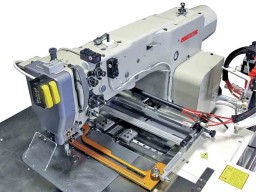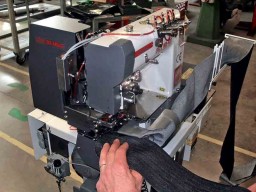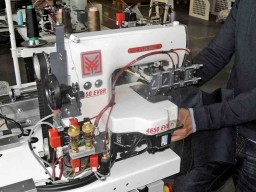
Though automation aids higher productivity and better quality, it also creates techno-phobia, a fear in the minds of the operators and mechanics regarding the flexibility and downtime. The introductory versions of automated machines had very complex settings for operators to understand and also it took substantial downtime for mechanics to repair or change settings. But not any more automated machines now display precise information connected to the problem that causes it. The functions that are aimed towards user ease include icons in the touch screen panel, multilingual support, ROM/flash memory-based diagnosis and specification setups in the machine. Team StitchWorld reviews operator-friendly automation in Vibemac, an Italian automated sewing machinery manufacturer.

Vibemac, the 30-year-old Italian company, specializes in manufacture of innovative industrial sewing machines for making quality fashion jeans and casual trousers. The company’s USP is the production of operator-friendly sewing machines using advanced technology. Today, the company has in the market the latest version of loop setting, pocket setting and automatic embroidery units, all of which are popular for their simple and clean operations. Another key feature of Vibemac machines, besides their sturdiness is offering the flexibility of operations which give the fashion-driven industry multiple options in the same machine.
Minimum time is required to change the setting of the machine and that too without any technical help because the common settings are already programmed and stored for easy and quick call back by the operator.

Among the easiest machines to operate is the programmable 1010V4F1 J-stitch with Mitsubishi PLK sewing head. In this machine an operator can change the sewing pattern with ease after just a few minutes of training because it is possible to store up to 500 different sewing patterns in the flash memory of the machine. Further, even the technicians can now make a new pattern directly on the machine, by means of the touch screen panel; it’s an easy and quick operation that takes a maximum of 5 minutes to upload using flash memory of the machine.
The same principle is applicable to the pocket setter 2516V4 and the pattern sewer 1010V4. Both these machines can be handled by the operators and is just a matter of changing a pattern using the same jig size; however, if there is a change in the size, it is advisable to ask the technician to make quick adjustments in the machine.
The machines are so flexible that the pocket setter can be converted into embroidery, velcro attaching, darts sewing and pleats making machine simply by changing jigs and program.
The new automated machines allow easy identification of malfunction and repair thereof – Even mechanics are guided by the machine as to where malfunction has happened.
[bleft]The new automated machinery lines from Vibemac allow easy identification of malfunction and repair thereof – Even mechanics are guided by the machine as to where malfunction has happened[/bleft]
In the PLK programmable units, the complete and clarified explanation is directly displayed on the touch screen panel. On other machines, the error displayed is a code and this code has its specification in the instruction manual. A machine that breaks down for some reason will never leave the customer technician clueless of the fault because the errors are clearly displayed on the touch panel. After reading where the fault lies the customer technicians has the option of either rectifying the fault on his own or contacting the company technicians.
Icons-based instructions on touch panel for easy understanding of operator instruction and setting panels in sewing machines so that operator need not read the full text of the functions, rather can select a function based on icons.

The need of the icons is huge for the programmable units, but regarding the non-programmable units, there is no need of making the machine more complicated, so Vibemac in its machines use an analog panel which is easily programmed. For example the waistband machine 3022WB201 has different programs for cutting the waistband (beginning and end, one cut or 2 cuts) and programme for the skip stitches (no need of helper who cuts and opens the mouth of the web). In the 2250PLC which is a 3 releasable needle machine, which by means of a Siemens panel, allows the operator to select a sequence of 4 steps of 1 or 2 needles. In both cases there is no need to go through the detailed explanation, but only to learn a few function codes that are useful.
Multi-lingual electronic panels for widespread understanding – Keeping in mind limitations of operators knowing English language, country specific local language are being used in instruction panel.
[bleft]Programme settings can be stored in a removable media floppy disk/USB drive and copied onto multiple machines[/bleft]
Programmable units use Mitsubishi software, where the most important languages of the 5 continents are used for instructions, so the icons are quite easy to understand. A few English words which are very common (on-off, stitch length and so on) are also used making the machine ready to be operated even by less educated workers. Regarding other units that are not programmable and use only an analog panel, users are required to learn few English words.
Programme settings can be stored in a removable media floppy disk/USB drive and copied onto multiple machines, thus maintaining consistency and repeatability (SPI or thread tension etc.) while also saving time.
Information sharing has become much easier because of floppy disk/flash memory based specifications which allow Vibemac to share new solutions to all its customers. This is particularly useful on the PLK-G where this exchange of data can be done by flash memory, on the PLK-E the information can be transferred by means of floppy disk.
Many a times, the left and right component of a garment has to be sewn in sequence and material movement in pairs (called Mirror Operations) for which the machine settings are now programmed automatically in the desired order.
An interesting example is asymmetric shape of back pocket sewing in jeans. The machine comes with 1 pocket creaser, 2 independent heads and 2 pocket setters, to be able to stitch 2 irregular/mirror pockets together. When the size changes, it takes just 3 minutes to change jigs and 5 seconds to change sewing pattern.
Smarter combination of operations for better efficiency.
The example is the 4650EV8R loop setter, which is able to save sequences of 10 bartacks in its memory, while also having the ability to differentiate a brand creating customized bartack. Taking the case of H&M that wants first loop with an ‘H’, one can choose the 1st bartack to be an ‘H’ and then 4 normal bartacks. In the next cycle, the 1st loop will again be an ‘H’ and so on. It is even possible to have a sequence of 5 different bartacks which repeats itself at every cycle.






